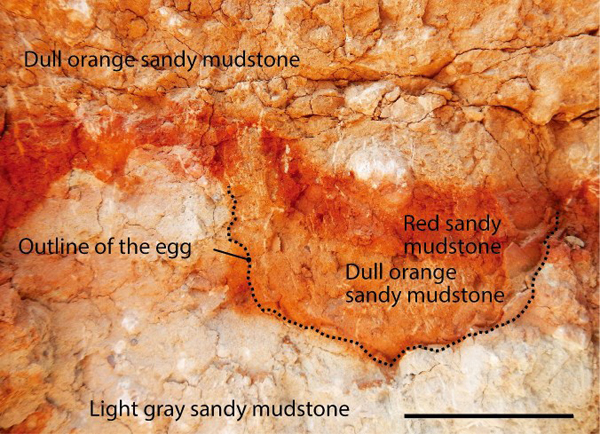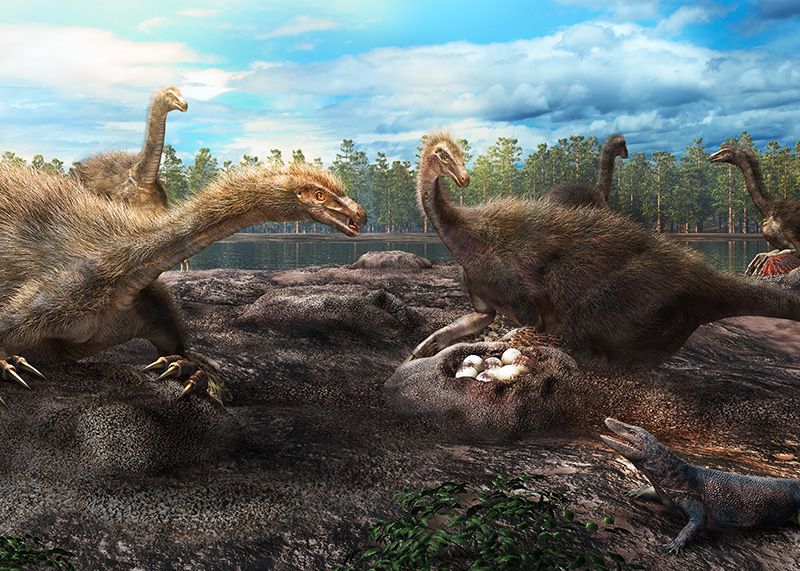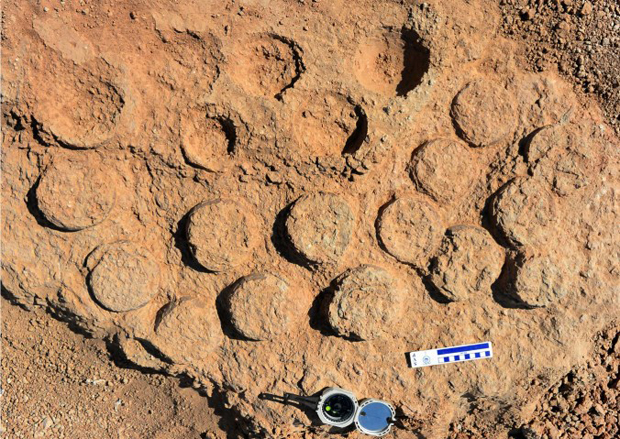Newly Published Research Concludes Dinosaurs Nested in Colonies
Mongolian Fossil Site Sheds Light on Theropod Nesting Behaviour
A team of international scientists writing in the academic journal “Geology”, have published a scientific paper that outlines strong evidence to indicate that at least some types of dinosaur nested communally and that the Dinosauria had a breeding season.
Theropod Nesting Behaviour
Communal nesting behaviour as seen in living theropods such as birds has been inferred in a variety of non-avian dinosaurs in the past. Famous fossil sites such as “Egg Mountain” in Montana, a nesting site for the hadrosaurid Maiasaura (and one or two troodontids too), that has provided high concentrations of nests preserved in a single location suggest that some types of dinosaurs nested in colonies, but the difficulty lay in proving that all the nests were created and the eggs laid at roughly the same time.
A new fossil nesting site discovered in the Upper Cretaceous Javkhlant Formation of the eastern Gobi Desert (Mongolia), preserves at least fifteen egg clutches laid by a probable non-avian theropod and this site provides strong evidence for colonial nesting in the dinosauria.
A Field Photograph of One of the Dinosaur Nests
Picture credit: Kohei Tanaka, (University of Tsukuba)
A Common Palaeosurface to the Fossil Finds
The researchers, which included scientists from the University of Calgary (Alberta, Canada), University of Tsukuba (Ibaraki Prefecture, Japan), Hokkaido University Museum (Hokkaido, Japan), and the Royal Tyrrell Museum (Alberta, Canada), studied fifteen egg clutches laid by a theropod dinosaur.
As all the eggs were very similar, (classified as the oofamily the Dendroolithidae), it is likely that all the nests were created by the same species of dinosaur. Communal nesting behaviour has been inferred before, but , at this fossil site, the mudstone and eggshell fragments that fell inside the eggs during, or soon after hatching, along with other sediments indicates the clutches were subsequently buried during a small flood event that deposited a thin red marker bed. It is this thin marker bed and the consistency of sediment infill among the eggs that indicates that these clutches were laid and hatched during a single season. In scientific terms, there is a common palaeosurface associated with the dinosaur nests and eggshell fragments.
A Natural Cross Section Through an Egg Showing the Palaeosurface

Picture credit: Kohei Tanaka, (University of Tsukuba)
Strong Evidence to Suggest that Some Dinosaurs Nested in Colonies Just Like Some Birds
The discovery of clutches of dinosaur eggs believed to have been laid by the same species of dinosaur, at the same level within the palaeosurface indicates that this is probably the fossilised remains of a single breeding season event.
A Hypothetical View of the Theropod Nesting Site (Therizinosaurs Nesting)

Picture credit: Masato Hattori
Using Vegetation to Incubate Eggs
The researchers conclude that despite the absence of sedimentologic evidence indicative of nest structure, statistical analyses of egg characteristics and facies association suggests that the clutches were likely incubated in covered or buried nests.
Some types of ground-nesting bird bury their eggs and use vegetation to help incubate and regulate the nest temperature. This behaviour is also found in that other extant branch of the Archosauria, the crocodilians. Furthermore, based on the number of nests and eggs found, the hatching success of the colony is estimated at around 60%. This hatching success is comparable to the hatching success found in crocodile nesting sites and amongst bird species that attend their nests and, very importantly, protect their nests from predators during the incubation period.
Therefore, it is likely that colonial nesting with parental attendance, widespread in living birds, likely evolved initially among non-brooding, non-avian dinosaurs to increase nesting success. In essence, the sort of nesting behaviours observed in living archosaurs today (birds and crocodiles), is probably a trait that evolved quite early on in the evolutionary history of the Archosauria.
Nest Guarding Behaviour in Dinosaurs
It has been inferred that dinosaurs protected their nests, based on evidence that some dinosaurs may have nested in groups. The percentage hatching success calculated from this site, reinforces that inference that some theropods may have defended their nest and, in all likelihood, their newly hatched offspring as well.
The oofamily Dendroolithidae is associated with therizinosaurs, although the eggs could have been laid by another type of dinosaur. Therizinosaurs are theropods but importantly, they are thought to be herbivorous and so in the life reconstruction, the nest builders are depicted as therizinosaurs breeding together as a form of protection against carnivorous theropods and other predators.
Everything Dinosaur acknowledges the assistance of a media release from the Royal Tyrrell Museum (Alberta) in the compilation of this article.
The scientific paper: “Exceptional preservation of a Late Cretaceous dinosaur nesting site from Mongolia reveals colonial nesting behavior in a non-avian theropod” by Kohei Tanaka; Yoshitsugu Kobayashi; Darla K. Zelenitsky; François Therrien; Yuong-Nam Lee; Rinchen Barsbold; Katsuhiro Kubota; Hang-Jae Lee; Tsogtbaatar Chinzorig; Damdinsuren Idersaikhan published in the journal Geology.
Visit the Everything Dinosaur website: Everything Dinosaur.


